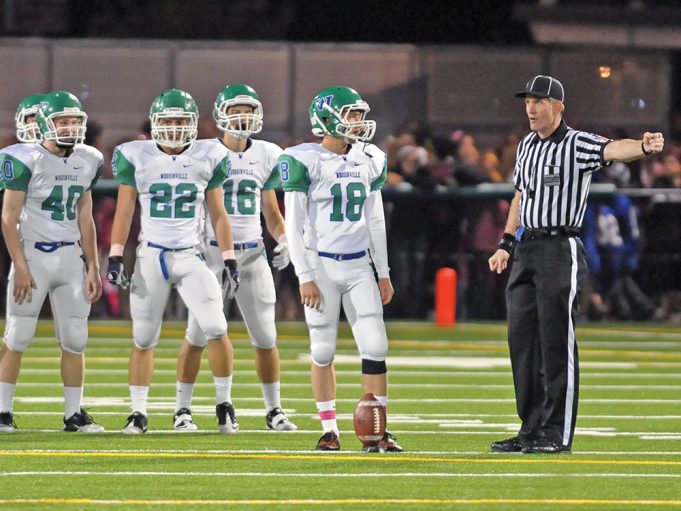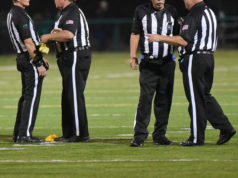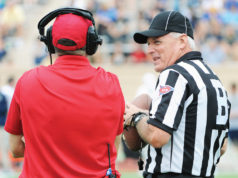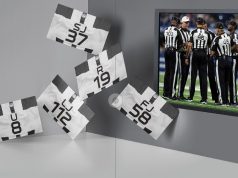By George Demetriou
Although every game begins with a kickoff, free kicks occur much less frequently than passing or running plays. Add the fact the kicking game has many special rules and you’ll recognize an extra effort is necessary to master kick plays.
A kickoff is a specific type of free kick used to start either half and to resume play after a try or successful field goal. Two of the three kicking methods (placekick and dropkick) can be used on a kickoff. A punt may not be used for a free kick but may be used for the kick that follows a safety. A kickoff can never score.
The most visible kickoff difference between the codes is the spot of the kick: It’s team K’s 40 yardline for NFHS and team K’s 35 yardline in NCAA. In both codes it’s the 20 yardline after a safety. When the ball is kicked, both teams must have all their players behind their free-kick (restraining) line except the kicking team may have the kicker and any holder over the line. Encroachment is a dead-ball foul in NFHS and a live-ball foul in NCAA (NFHS 6-1-3; NCAA 6-1-2b).
Under NCAA rules, if team K is offside, the penalty may be enforced from the previous spot or from the spot where the ball becomes dead in team R’s possession. In NFHS, a foul by team K other than kick catch interference during the kick may be enforced from the succeeding spot if team K is not next to put the ball in play.
There are also a couple of formation requirements on the kicking team and one on the receiving team. Team K must have at least four players on either side of the kicker. In NFHS, no team K player other than the kicker may be more than five yards behind the free-kick line. In NCAA, all team K players must have been between the numbers after the ready-for-play signal. It is illegal for three or more members of team R to intentionally form a wedge for the purpose of blocking for the runner except when the kick is from an obvious onside kick formation. A wedge is defined as three or more players aligned shoulder to shoulder within two yards of each other. There is no restriction on the initial formation before the ball is kicked, but the rule applies after the ball has been kicked, even if the wedge is formed after the kick has been caught (6-1-9).
The end zone. If the kick goes into team R’s end zone, the ball is dead in NFHS and it is a touchback. Force is not a factor. In NCAA, the ball is also dead for a touchback when the ball touches anything in team R’s end zone unless it was touched by a team R player before it touched the ground in the end zone (NFHS 4-2-2d1; NCAA 6-1-7).
Play 1: R1 is standing in his end zone when he (a) catches a free kick, or (b) recovers a free kick after it has bounced on team R’s two yardline. R1 then takes off down the sideline for a touchdown. Ruling 1: In NFHS, it is a touchback in (a) and (b). The ball is dead when it breaks the plane of team R’s goalline. In NCAA, the plays stand; the ball remains live because it did not touch the ground in the end zone.
Play 2: R1, standing on his five yardline, touches a kickoff as the ball bounces past him. The ball (a) rolls into the end zone where it is recovered by K4, or (b) bounces into the end zone, where K6 recovers before the ball touches the ground. Ruling 2: In NFHS, the ruling is the same as in play 1. But in NCAA, it is a touchdown for team K in both (a) and (b). Because R1 touched the kick in the field of play, either team may legally recover. When team K recovers in team R’s end zone, it is a touchdown.
Play 3: A kickoff bounces off R1’s chest at his three yardline. The ball is nearly at rest on team R’s two yardline when R1, in his haste to recover the ball, muffs and forces the ball into the end zone and across the sideline. Ruling 3: In both codes, that is a touchback. The kick supplied the force (NFHS) or impetus (NCAA).
In NCAA rules, if the ball had been at rest and the muff provided a new impetus, the result would be a safety.
Kicks out of bounds. If the ball is kicked so that it goes out of bounds untouched by the receiving team in the field of play, it is a foul. The receiving team may choose:
- A rekick after enforcement of a five-yard penalty from the previous spot.
- Accept the result of the play and take the ball at the yardline where it went out of bounds.
- Begin a new series 25 yards (NFHS) or 30 yards (NCAA) from the previous spot.
In NFHS, team R may accept a five-yard penalty from the succeeding spot (NFHS 6-1-9; NCAA 6-2-1).
If penalties create a situation in which placing the ball the prescribed yards from the previous spot would put the ball in team R’s end zone, that option cannot be offered (NFHS 6.1.9H; NCAA 10-2-2h).
Play 4: K1 kicks off and the ball goes out of bounds untouched (a) 15 yards from where it was kicked, or (b) at team R’s 10 yardline. Ruling 4: In (a), team R will likely elect to take the ball at the out-of-bounds spot. In (b), team R would be wise to take the ball at its 35 yardline in NFHS and at its 40 yardline in NCAA.
Play 5: A team R player muffs a free kick. An airborne team K player gets his hands on the ball and comes to the ground out of bounds. Ruling 5: The ball became dead when the team K player possessed it out of bounds. But because team R touched the kick before it went out of bounds, there is no foul on team K. It will be team R’s ball at the spot the team K player went out of bounds.
In NFHS, a pop-up kick results in a dead-ball foul. A pop-up kick is a free kick in which the kicker drives the ball immediately into the ground, the ball strikes the ground once and goes into the air in the manner of a ball kicked directly off the tee (2-24-10, 6-1-11 Pen.). If that type of kick is attempted in NCAA, a receiver who gives a fair catch signal is entitled to the same protection as if the ball were kicked in a conventional manner (6-4-1f).
In NCAA only, if a team R player gives a valid or invalid fair catch signal and the ball is caught inside his own 25 yardline, team R begins a new series at its own 25 yardline.
Blocking. The kicker on a free kick may not be contacted until he has advanced five yards beyond his free-kick line or the kick has touched the ground or any other player. In NCAA, the ball may also touch an official or the ground (NFHS 9-3-4; NCAA 6-1-9).
Team K players may start blocking opponents when team K is eligible to touch the kick. In NFHS that’s when a legal kick has traveled 10 yards or after it goes beyond the plane of team R’s free-kick line and touches the ground (in either order), or after it touches a team R player. Restrictions on team K blocking end if team R initiates a block within the neutral zone. Violations result in a 10-yard penalty (9-3-8 Pen.). For NCAA, team K is eligible to touch a free kick after it touches a team R player, after it breaks the plane of and remains beyond team R’s restraining line or after it touches the ground, any player or an official beyond team R’s restraining line. The penalty is five yards from the previous spot (6-1-12 Pen., AR 6-1-3 II).
First/illegal touching. When team K touches a free kick and is not entitled to possession, it is a violation termed first touching (NFHS) or illegal touching (NCAA). That occurs when team K is first to touch the ball after it has touched the ground, but before it has traveled 10 yards, or before a team R player touches it. That violation gives team R the option to take the ball at any spot of first touching, as long as it does not touch the ball and subsequently foul (NFHS only), or there is an accepted penalty for a player foul, or offsetting fouls (NFHS 6-1-6; NCAA 6-1-3).
Play 6: K1’s kickoff goes five yards and is downed by (a) R4, or (b) K5. Ruling 6: In both cases it will be team R’s ball, first and 10 at the spot of the recovery. In (b), team R will choose to take the ball at the spot of first touching.
Play 7: K1’s kickoff goes eight yards and is muffed by R3. The ball is then downed by (a) R6, or (b) K8. Ruling 7: In (a), it will be team R’s ball, first and 10 at the spot of the recovery. In (b), it will be team K’s ball, first and 10 at the spot of the recovery. First touching or illegal touching only applies when team K touches the kick before team R and prior to the ball traveling 10 yards.
Once the ball travels 10 yards both teams are generally entitled to possession, but there is one significant difference between the codes.
Play 8: K1’s kickoff is short and high and goes about 20 yards. There are no team R players anywhere near the descending ball. The ball is caught by K2. Ruling 8: In NFHS, that is kick-catch interference. It is not first touching because the ball traveled beyond team R’s free-kick line. If the game is played under NCAA rules, there is no foul because a team R player was not in position to catch the ball. Team K keeps the ball, first and 10 at the spot of the catch.
George Demetriou has been a football official since 1968. He lives in Colorado Springs, Colo.
What's Your Call? Leave a Comment:
Note: This article is archival in nature. Rules, interpretations, mechanics, philosophies and other information may or may not be correct for the current year.
This article is the copyright of ©Referee Enterprises, Inc., and may not be republished in whole or in part online, in print or in any capacity without expressed written permission from Referee. The article is made available for educational use by individuals.



















